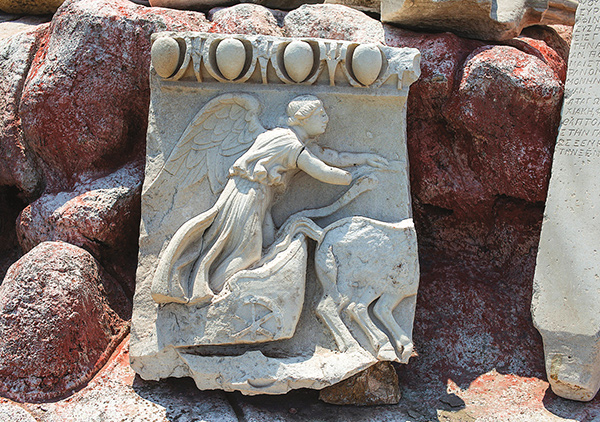Archaeological Views: Turkey’s Treasures in Trouble

024
I’ve visited more than 300 ancient cities throughout Turkey that date back to the Greek, Hellenistic and Roman periods. Most of them have never been excavated, and many of them are scarcely known. For some places only the names used by the modern residents remain—the ancient ones forgotten to time. Others are currently underneath modern Turkish cities, but most of them are located in remote, seldom-visited regions.
For protection, many of these villages and towns were built on mountaintops or on strategically located precipices. Over the centuries, trees and brush have covered these sites and have made visitation very difficult. In many instances, there are no modern roads that lead to the sites. At other times, a rutted dirt road or a cow path is all that leads nearby. Directions to these unmarked sites are unclear and difficult to find. Even the best Turkish roadmaps (in a book titled Köy Köy Türkiye Yol Atlasi) mismarks about 40 percent of the ancient sites, by my estimate. To locate these places, my strategy has been to talk to nearby villagers.
On one trip I came to Balkıs, a small village in northwest Turkey in search of the ruins of the ancient city of Kyzikos. As I turned off the road and pulled into the lot of a small cafe, the eyes of a dozen men stared at me. In Turkey men commonly gather at the village cafe and sip çay (tea) at tables outside. I was a stranger, and they don’t typically see many strangers in Balkıs. After a few customary greetings, I was invited to sit and offered çay. I don’t like çay, but I drank it anyway, knowing that I was making a connection with the villagers. Whatever discussions the men were having prior to my arrival were now suspended, and I was the focus of their attention. In short order, the questions came: “Where are you from?” and “What are you doing here?” I explained that I was a professor at an American university, and I was interested in examining the ancient ruins of Kyzikos. Most of the men were not familiar with the name Kyzikos, but I explained that I was looking for an ancient city located in the woods and surrounding countryside. Most of the men knew of ruins that existed out in the brush, but they didn’t know anything about them. After a bit of discussion, the men determined that Ahmet (not his real name), one of the men, should accompany me to the ruins.
Ahmet spent the rest of the day showing me the extensive ruins of ancient Kyzikos. Of particular interest were the ruins of the ancient amphitheater. Only three amphitheaters are known in ancient Anatolia, and one of them is in Kyzikos. We trekked through trees and heavy brush for two hours before arriving at the amphitheater ruins.

At the end of the day, Ahmet insisted that I have dinner with him and his family. Ahmet actually lives within the Roman baths of Kyzikos. Before dinner Ahmet introduced me to his neighbor, who had returned from prison about a year previously. His neighbor had been caught trying to sell antiquities on the black market. He explained to 068 me that he had dug up a frieze with a beautiful relief of winged charioteers. He broke up the relief panel to smuggle the pieces out of the country, but he was caught and jailed. As we were talking, it dawned on me that I had just seen a frieze similar to this at the Bandırma Museum the day before. I was puzzled when I viewed the objects because the frieze appeared to have fresh breaks, and the separate pieces had newly exposed surfaces. I pulled out my camera and flipped back to the shots I had taken a day earlier. As I showed the photos to Ahmet and his neighbor, they affirmed that this was the frieze that Ahmet’s neighbor had uncovered. Undeterred, Ahmet’s neighbor continued his clandestine activities. To him, the rewards far outweighed the risks.
Illegal digs are ubiquitous in Turkey. Almost all of the sites are not protected by fences; guards often find evidence of illegal digs.
Last year at another village in Turkey, I met a new friend who accompanied me to ruins in the nearby hills. At the end of the day, we returned to the village cafe, where we talked to several people who boasted about the objects they’d found. With so many objects available on the black and gray markets, collectors and curators are tempted to acquire impressive pieces that cannot be properly vetted. In recent years, the Metropolitan Museum of Art in New York was forced to return the so-called Lydian Treasure, and Boston’s Museum of Fine Arts returned a large statue of Herakles to Turkey.
Simply put, Turkey has vast treasure buried underground. In the past, Turkey scarcely realized the value of its hidden treasures and was ill-prepared to excavate them. Today, however, Turkey’s universities are training the next generation of historians and archaeologists who are eager to explore Turkey’s past. In recent years, a few new digs have begun at some sites around the country. But Turkey’s resources are limited. Meanwhile, scores of ancient sites are left unprotected and are being ravaged by locals who are hoping to hit the jackpot.
I’ve visited more than 300 ancient cities throughout Turkey that date back to the Greek, Hellenistic and Roman periods. Most of them have never been excavated, and many of them are scarcely known. For some places only the names used by the modern residents remain—the ancient ones forgotten to time. Others are currently underneath modern Turkish cities, but most of them are located in remote, seldom-visited regions. For protection, many of these villages and towns were built on mountaintops or on strategically located precipices. Over the centuries, trees and brush have covered these sites and have made visitation very […]
You have already read your free article for this month. Please join the BAS Library or become an All Access member of BAS to gain full access to this article and so much more.
